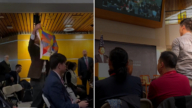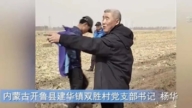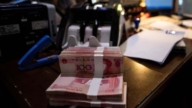【新唐人2015年02月06日訊】中共央行4號突然宣佈,5號起下調金融機構人民幣存款準備金率0.5個百分點。這個消息結合日前公布的中國資本賬戶創記錄逆差,以及1月份製造業PMI創2年半來新低,引發了市場的不安。有分析指出,央行這次降準能起到短期作用,GDP增長不至於降到7%以下,但無法改變經濟下滑的長期趨勢。
據央行公告,自2月5號起下調金融機構人民幣存款準備金率0.5個百分點,這是超過兩年半以來的首次降準決定。大型金融機構由此前20%的存款準備金率降至19.5%,而中小金融機構由此前16.5%的存款準備金率降至16%。
此外,央行加大對小微企業、「三農」以及重大水利工程建設的支持力度,對小微企業貸款佔比達到定向降準標準的城市商業銀行、非縣域農村商業銀行,額外降低人民幣存款準備金率0.5個百分點,對中國農業發展銀行額外降低人民幣存款準備金率4個百分點。
交通銀行金融研究中心研究員徐博向《北京商報》表示,這次降準大約能釋放6000億到7000億人民幣的流動性。中信證券宏觀團隊認為,根據當前的基礎貨幣和準備金率,這次降準大約能導致貨幣總量增加2萬億元以上。
美國大唐集團中國區首席經濟學家謝作詩指出,央行這次降準反映了中國實體經濟的困難。
美國大唐集團中國區首席經濟學家謝作詩:「0513它降準就可見實體經濟困難,這是一個甚麼背景,是熱錢的外流、人民幣面臨貶值壓力,對美元貶值壓力,在這樣一個背景之下,它來降準,那當然是反映出實體經濟困難的局面了。」
中共國家統計局和物流與採購聯合會2月1號公布的數據顯示,1月官方製造業採購經理人指數(PMI)降到49.8,跌破景氣榮枯分界線50,創2012年9月以來新低,非製造業PMI也降到一年來新低53.7。
而中共外匯管理局網站也在3號公布,去年第4季中國資本和金融帳戶逆差達912億美元,是1998年以來最大的資本帳戶赤字。
美國《彭博通訊社》引述瑞穗證券亞洲駐香港首席經濟學家瀋建光的話指出,外管局公布的數據表明,中國的經濟結構發生變化,人民幣貶值的預期,推動了資本外流。
美國中文雜誌《中國事務》總編輯伍凡指出,中國經濟下滑、資金外逃,加上年關將至,促使央行必須採取降準的動作。
美國中文雜誌《中國事務》總編輯伍凡:「經濟下滑非常明顯,一月份的PMI指數已經降到了49.8。現在年關要到了,市面上錢非常緊,原因就是910億美金,從人民幣換掉,換成910億美金,跑掉了。第二,你生產下滑,沒有利潤回來,發不出薪水,而年關到了,員工要錢,要過年,所以它不得不放這個錢,來支撐這些國營企業和民間企業。」
不過,伍凡認為,央行放出的這些錢會跑到股市,對實體經濟沒有幫助。
伍凡:「中國降準、降息,放了幾千億美金出來,實際上也是一種變相的量化寬鬆,可是,錢的走向會到哪裏去,我估計很可能還會走上股票市場,因為放到實體經濟沒有效益,不能夠產生利潤嘛,它不如放到股票市場去炒作,所以放這麼多的錢,根本對中國的實體經濟不會有任何好處,起不了作用。可是它目前過年了,不得不放。」
澳新銀行經濟學家劉立剛認為,央行這次降準的主要原因是,1月份PMI遠遠低於預期,如果沒有進一步政策反應,那麼今年第一季度GDP增長很可能跌到7%以下。
據了解,央行去年11月突然降息,2014年全年GDP較上年增長7.4%,為近24年新低,勉強實現「7.5%左右增長」的政府目標。
謝作詩:「肯定政府是怕經濟巨幅的下滑,巨幅的滑到7以下,那它是可怕的。巨幅下滑可能就會造成企業倒閉、爆發金融危機、引起社會不穩定,它怕的是這個。」
謝作詩指出,無論是央行這次降準,或者將來更多的降準、降息,都阻止不了中國經濟下滑的趨勢,不可能光靠一個貨幣政策改變這個趨勢,不過它確實可以拖一下,讓經濟不致於巨幅掉下來。
採訪/易如 編輯/陳潔 後製/舒燦
Analysts: the CCP’s Abrupt Cut in RRR is to Prevent Big Fall in GDP Growth
The Chinese Communist Party’s (CCP) Central Bank
announced abruptly on Feb. 4 that the required reserve ratio
(RRR) for CNY will be cut by 0.5 percentage point
beginning on the 5th.
The news, along with China’s biggest capital outflow
and record-low January PMI seen in 2.5 years,
jitters the global market.
Analysts said the cut in RRR may work temporarily
to keep GDP growth above seven percent;
however, it cannot stop the long-term slide
in China’s economy.
The People’s Bank of China (PBoC) announced
that the RRR for Chinese Yuan would be cut
by a 0.5 percentage point begining Feb. 5.
The move is the first RRR cut since
two and a half years ago.
Big banks are now required to hold 19.5 percent
(down from 20 percent) of their deposits as reserves,
and smaller banks’ RRR dropped to 16 percent
from 16.5 percent.
In addition, PBoC stepped up support
for small or micro businesses, farmers
and the agriculture industry and major water projects.
An additional RRR cut of 0.5 percentage point
was announced for city commercial banks
and non-county-level rural commercial banks
that are eligible for the policy.
An extra RRR cut of four percentage points was also
announced for the Agricultural Development Bank of China.
Xu Bo, Bank of Communications Research Center researcher,
told Beijing Business News that the move can create
extra liquidity capacity of 96 to 112 billion dollars
(600 to 700 billion CNY).
CITIC Securities Macro-economy Team estimates that
the RRR cut will increase China’s monetary base
by over $320 billion (2 trillion CNY) according
to the current base currency and reserve ratio.
Xie Zuoshi, chief economist of American Da Tang Group
in China, commented that the cut in RRR results
from difficulties the CCP is facing in the economy.
Xie Zuoshi: “The cut in RRR is a result of difficulties
in real economy.
The backdrop is huge capital outflow and downward
pressure on CNY, especially against dollars.
The cut in RRR is announced in such a situation; therefore
it is without a doubt an indication of economic troubles."
The CCP’s National Bureau of Statistics and China Federation
of Logistics & Purchasing jointly announced on Feb. 1 that
China’s official Purchasing Managers’ Index (PMI)
fell to 49.8 in January.
This PMI drops below the 50-point level that separates
growth from contraction on a monthly basis,
and is a record-low since September 2012.
The official non-manufacturing PMI also fell to 53.7,
a record-low in the past year.
On Feb. 3, the CCP’s State Administration of Foreign
Exchange (SAFE) also announced a fourth-quarter deficit
of $91.2 billion in capital and financial accounts.
The figure is again a record-high since 1998.
A Bloomberg interview with Shen Jianguang,
chief Asia economist at Mizuho Securities Asia Limited,
commented that the official SAFE statistics suggest
a structural change in China’s economy;
the anticipation in CNY depreciation further drives
more capital to flow out of China.
Wu Fan, chief-in-editor of China Affairs magazine said
the economic slide, capital outflow and the upcoming
Chinese New Year are factors forcing PBoC
to make the RRR cut.
Wu Fan: “It is easy to see the economic slowdown in China
as January’s PMI fell to 49.8.
As the Chinese New Year is approaching, China’s market
is short of money because $91 billion escaped from China.
In addition, declines in the manufacturing industry
leads to problems in wage payment.
Employees need money to spend during the holiday,
so the Central Bank has to release some reserves
to the market, to support both state-owned
and private enterprises."
On the other hand, Wu Fan believes the released liquidity
will mostly be used in the stock market and thus helps
little in China’s real economy.
Wu Fan: “The CCP released hundreds of billions of dollars
by cutting RRR and the interest rate.
This can be regarded as another form of quantitative easing.
However, where will the money go?
I think probably the stock market.
The reason is the capital can make little profits
if being put into the real economy right now.
So people will prefer to invest in the stock market.
If so, the released capital can hardly benefit
China’s real economy.
But there is no other choice as the Chinese New Year
is coming."
Liu Ligang, economist of ANZ Bank, said the RRR cut
mostly results from the much worse PMI performance
than expected in January.
With no administrative interference, China’s GDP growth
will probably fall to below seven percent in the first quarter
of 2015.
The PBoC made an abrupt cut in interest rates
last November.
As a result, the CCP announced a GDP growth
of 7.4 percent in 2014, a record-low in 24 years.
However, it still barely achieved the goal of 7.5 percent
in GDP growth.
Xie Zuoshi: “The CCP government must be afraid
of a huge economic slide.
If the GDP growth falls below seven percent then that
will be horrifying.
A huge economic slide may lead to mass bankruptcy,
financial crisis and social instability.
These are what the CCP is most afraid to see."
Xie Zuoshi concluded that no matter how many times PBoC
cuts RRR or interest rates, there is no way
to stop China’s economic slowdown.
Any single monetary policy will never reverse the trend.
On the other hand, these moves do have temporarily effects
in preventing a sudden economic collapse.
Interview/YiRu Edit/ChenJie Post-Production/ShuCan




























